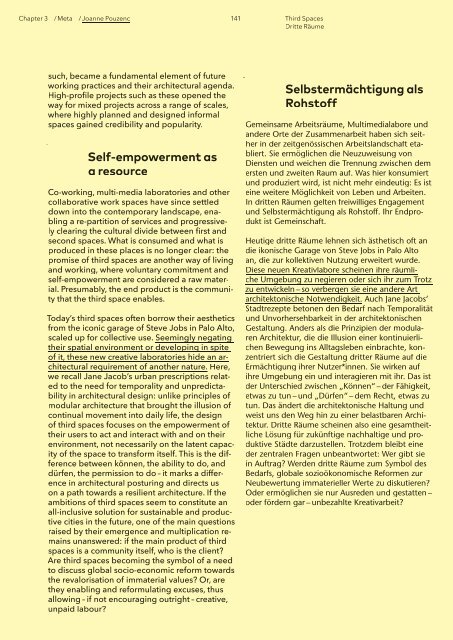Make City – A Compendium of Urban Alternatives Stadt anders machen
ISBN 978-3-86859-567-3 https://www.jovis.de/de/buecher/product/make-city.html
ISBN 978-3-86859-567-3
https://www.jovis.de/de/buecher/product/make-city.html
Create successful ePaper yourself
Turn your PDF publications into a flip-book with our unique Google optimized e-Paper software.
Chapter 3 / Meta / Joanne Pouzenc<br />
141<br />
Third Spaces<br />
Dritte Räume<br />
such, became a fundamental element <strong>of</strong> future<br />
working practices and their architectural agenda.<br />
High-pr<strong>of</strong>ile projects such as these opened the<br />
way for mixed projects across a range <strong>of</strong> scales,<br />
where highly planned and designed informal<br />
spaces gained credibility and popularity.<br />
<strong>–</strong><br />
Self-empowerment as<br />
a resource<br />
Co-working, multi-media laboratories and other<br />
collaborative work spaces have since settled<br />
down into the contemporary landscape, enabling<br />
a re-partition <strong>of</strong> services and progressively<br />
clearing the cultural divide between first and<br />
second spaces. What is consumed and what is<br />
produced in these places is no longer clear: the<br />
promise <strong>of</strong> third spaces are another way <strong>of</strong> living<br />
and working, where voluntary commitment and<br />
self-empowerment are considered a raw material.<br />
Presumably, the end product is the community<br />
that the third space enables.<br />
Today’s third spaces <strong>of</strong>ten borrow their aesthetics<br />
from the iconic garage <strong>of</strong> Steve Jobs in Palo Alto,<br />
scaled up for collective use. Seemingly negating<br />
their spatial environment or developing in spite<br />
<strong>of</strong> it, these new creative laboratories hide an ar-<br />
chitectural requirement <strong>of</strong> another nature. Here,<br />
we recall Jane Jacob’s urban prescriptions related<br />
to the need for temporality and unpredictability<br />
in architectural design: unlike principles <strong>of</strong><br />
modular architecture that brought the illusion <strong>of</strong><br />
continual movement into daily life, the design<br />
<strong>of</strong> third spaces focuses on the empowerment <strong>of</strong><br />
their users to act and interact with and on their<br />
environment, not necessarily on the latent capacity<br />
<strong>of</strong> the space to transform itself. This is the difference<br />
between können, the ability to do, and<br />
dürfen, the permission to do <strong>–</strong> it marks a difference<br />
in architectural posturing and directs us<br />
on a path towards a resilient architecture. If the<br />
ambitions <strong>of</strong> third spaces seem to constitute an<br />
all-inclusive solution for sustainable and productive<br />
cities in the future, one <strong>of</strong> the main questions<br />
raised by their emergence and multiplication remains<br />
unanswered: if the main product <strong>of</strong> third<br />
spaces is a community itself, who is the client?<br />
Are third spaces becoming the symbol <strong>of</strong> a need<br />
to discuss global socio-economic reform towards<br />
the revalorisation <strong>of</strong> immaterial values? Or, are<br />
they enabling and reformulating excuses, thus<br />
allowing <strong>–</strong> if not encouraging outright <strong>–</strong> creative,<br />
unpaid labour?<br />
<strong>–</strong><br />
Selbstermächtigung als<br />
Rohst<strong>of</strong>f<br />
Gemeinsame Arbeitsräume, Multimedialabore und<br />
andere Orte der Zusammenarbeit haben sich seither<br />
in der zeitgenössischen Arbeitslandschaft etabliert.<br />
Sie ermöglichen die Neuzuweisung von<br />
Diensten und weichen die Trennung zwischen dem<br />
ersten und zweiten Raum auf. Was hier konsumiert<br />
und produziert wird, ist nicht mehr eindeutig: Es ist<br />
eine weitere Möglichkeit von Leben und Arbeiten.<br />
In dritten Räumen gelten freiwilliges Engagement<br />
und Selbstermächtigung als Rohst<strong>of</strong>f. Ihr Endprodukt<br />
ist Gemeinschaft.<br />
Heutige dritte Räume lehnen sich ästhetisch <strong>of</strong>t an<br />
die ikonische Garage von Steve Jobs in Palo Alto<br />
an, die zur kollektiven Nutzung erweitert wurde.<br />
Diese neuen Kreativlabore scheinen ihre räumli-<br />
che Umgebung zu negieren oder sich ihr zum Trotz<br />
zu entwickeln <strong>–</strong> so verbergen sie eine andere Art<br />
architektonische Notwendigkeit. Auch Jane Jacobs‘<br />
<strong>Stadt</strong>rezepte betonen den Bedarf nach Temporalität<br />
und Unvorhersehbarkeit in der architektonischen<br />
Gestaltung. Anders als die Prinzipien der modularen<br />
Architektur, die die Illusion einer kontinuierlichen<br />
Bewegung ins Alltagsleben einbrachte, konzentriert<br />
sich die Gestaltung dritter Räume auf die<br />
Ermächtigung ihrer Nutzer*innen. Sie wirken auf<br />
ihre Umgebung ein und interagieren mit ihr. Das ist<br />
der Unterschied zwischen „Können“ <strong>–</strong> der Fähigkeit,<br />
etwas zu tun <strong>–</strong> und „Dürfen“ <strong>–</strong> dem Recht, etwas zu<br />
tun. Das ändert die architektonische Haltung und<br />
weist uns den Weg hin zu einer belastbaren Architektur.<br />
Dritte Räume scheinen also eine gesamtheitliche<br />
Lösung für zukünftige nachhaltige und produktive<br />
Städte darzustellen. Trotzdem bleibt eine<br />
der zentralen Fragen unbeantwortet: Wer gibt sie<br />
in Auftrag? Werden dritte Räume zum Symbol des<br />
Bedarfs, globale sozioökonomische Reformen zur<br />
Neubewertung immaterieller Werte zu diskutieren?<br />
Oder ermöglichen sie nur Ausreden und gestatten <strong>–</strong><br />
oder fördern gar <strong>–</strong> unbezahlte Kreativarbeit?


















